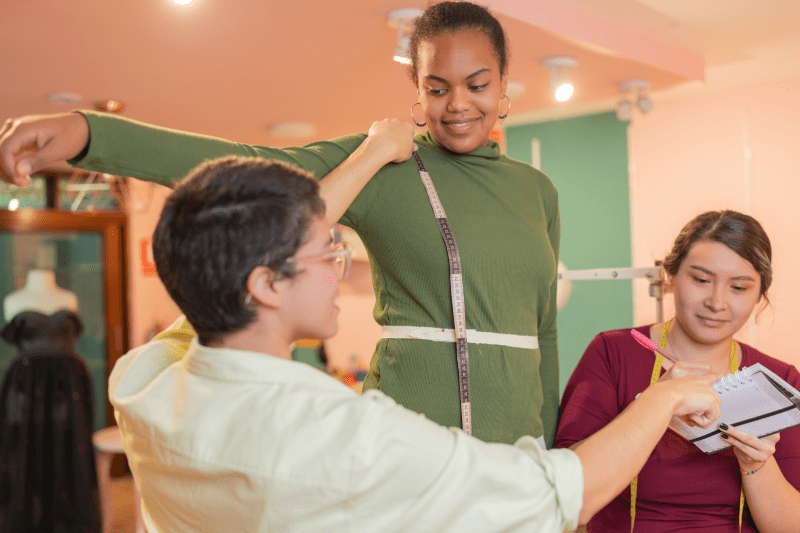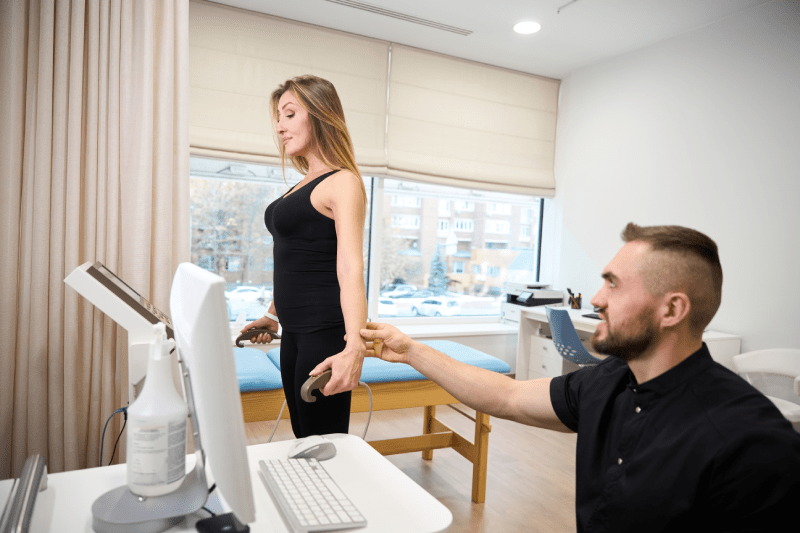Is Height Reduction Surgery Truly Possible And How Is It Performed?
Height reduction surgery is an orthopedic procedure applied to alleviate social and psychological distress caused by being very tall, or to correct leg length discrepancies. This surgery typically involves the careful shortening of leg bones (femur or tibia). In the surgical process, a segment of the bone is removed, and the two ends are rejoined using special plates and screws.
The goal is to achieve the desired height without disrupting the body’s overall proportion. Such aesthetic and functional correction procedures are performed with great meticulousness and success thanks to advanced surgical techniques. As Cure Holiday, we are with you at every stage of this delicate process and provide detailed information about the entire procedure.
Who Is Suitable For Height Reduction Surgery?
Height reduction surgery is generally suitable for young adult women who are concerned about their height for psychological or social reasons, have completed bone development, and are in good general health. The patient applying should typically have a healthy Body Mass Index (BMI) and be expected to minimize habits that negatively affect healing, such as smoking.
Furthermore, it is important that the patient’s expectations from the surgery are realistic and that they can adapt to the long recovery process. A comprehensive psychological and orthopedic evaluation before the surgery plays a vital role in determining suitability for this complex operation.
Is There An Age Limit For Height Reduction Surgery In Women?
The lower age limit for height reduction surgery is the point at which the individual has fully completed their skeletal development. This typically corresponds to around 18-20 years of age for women. The complete closure of bone growth plates is critically important for the success of the operation and the quality of bone healing. Although there is no strict upper age limit, risks may increase in older patients due to decreased bone density (osteoporosis) and slower healing rates. Therefore, patients aged 40 and over must undergo a much more detailed bone health and general health check before deciding on the surgery.
What Is The Maximum Amount Of Shortening That Can Be Done In The Surgery?
The maximum amount of shortening that can be applied is limited in order to protect body proportion and functional capacity. Generally, shortening between 5 and 8 centimeters in a single leg segment (for example, in the femur alone) is considered safe. Performing more shortening can lead to excessive tension or laxity in the surrounding muscles, tendons, and nerves, potentially impairing walking mechanics and joint functions. Surgeons carefully measure the patient’s current height, leg length, and body proportion to determine the safest and most aesthetically pleasing amount. This planning ensures a personalized treatment protocol is created.
What Are The Risks And Complications Of Height Reduction Surgery?
As with any major surgical procedure, height reduction surgery carries certain risks. These include infection, nerve and blood vessel damage, delayed bone healing (non-union), blood clot formation (thrombosis), and gait disturbances. Strict adherence to post-operative care protocols is mandatory to minimize the risk of infection. An experienced surgical team and modern hospital environment play a critical role in minimizing these risks. Before the surgery, potential risks and complications must be explained in detail to the patient, and their consent obtained. Cure Holiday collaborates only with centers that maintain high standards.

How Does The Post-Operative Recovery Process Work?
The post-operative recovery process is typically a long and patience-demanding marathon. The first phase involves a few days spent in the hospital (usually 3-7 days), followed immediately by an intensive physical therapy program. While the bone healing time varies from person to person, it may take months for complete union to occur and for the patient to bear full weight while walking. The first 6-8 weeks generally require the use of crutches or a walker. The speed of recovery is directly proportional to the patient’s age, overall health, nutrition, and commitment to physical therapy. Regular doctor check-ups and X-ray monitoring are essential during this period.
Are The Incision Scars Formed After Surgery Permanent?
Depending on the techniques used in height reduction surgery, small surgical incisions are made. The visibility of these incision scars varies from person to person and depends on the wound healing capacity. Modern surgical techniques aim to keep scars as small as possible and place them in inconspicuous areas. Scars may be noticeable in the first few months, but they fade over time with proper wound care, becoming less noticeable. Once healing is complete, cosmetic procedures like laser treatment or specialized creams can also be applied to improve the appearance of the scars.
Can Another Procedure Be Performed Concurrently With Height Reduction Surgery?
Yes, in some cases, concurrent or sequential aesthetic or orthopedic procedures may be planned to optimize the patient’s overall body proportion. For example, alongside the shortening of the legs, existing bowing or angular deformities of the legs can also be corrected, if present. However, performing large and complex surgeries simultaneously can prolong the recovery process and increase the risk of complications. Therefore, the suitability of combined procedures must be carefully evaluated by the surgical team, taking into account the patient’s health status and the magnitude of the operation. Priority is always given to patient safety and functional recovery.
Which Medical Tests Should Be Performed Before The Surgery?
A comprehensive medical evaluation is mandatory before height reduction surgery. These tests include detailed blood analyses, electrocardiography (ECG), chest X-ray, and specialized X-rays (Scanogram or Orthopedic Evaluation Radiograph) for length and angular assessment of the leg bones. Additionally, all necessary tests to determine bone density measurements and suitability for anesthesia are performed. This comprehensive evaluation is critically important to determine if there are any contraindications in the patient’s general health status for the surgery to be performed safely. Cure Holiday assists you in organizing these tests during the preparation phase.
How Long Does The Height Reduction Surgery Take?
The duration of the height reduction surgery varies depending on the leg segment to be shortened (femur or tibia) and the complexity of the surgical technique applied. Generally, a standard shortening operation performed on a single bone segment can last between 2 and 4 hours, including anesthesia preparation. This duration may be extended if shortening is performed simultaneously on both legs or if additional corrective procedures are required. Experienced surgical teams aim to minimize the surgery time to reduce the patient’s time under anesthesia, which positively affects overall recovery.
Is The Shortening Procedure More Commonly Preferred In The Femur Or The Tibia?
The shortening procedure in height reduction surgery is generally preferred in the femur, which is the thigh bone, but the tibia (shin bone) can also be used. The femur is a thicker and stronger bone, so it may be more tolerant of bearing body weight after a certain degree of shortening. Tibia shortening is planned specifically when correction of lower leg disproportion is needed, or according to the patient’s surgical requirements. The decision on which bone to shorten is determined individually based on the patient’s current height ratio, the desired amount of shortening, and the surgeon’s expertise.
Is The Post-Operative Physical Therapy Process Mandatory?
Yes, it is absolutely mandatory. Height reduction surgery is not only bone surgery but also a procedure that affects muscle and joint functions. Stress can occur on the muscles, tendons, and ligaments as they try to adapt to the shortened bone. Physical therapy is vital for preventing joint stiffness (contracture), regaining muscle strength, and relearning the correct walking pattern. Regular sessions managed by expert physiotherapists form the cornerstone of the recovery process for achieving full functional recovery and successful outcomes.
How Is Pain Management Provided After Height Reduction Surgery?
Pain is inevitable in the post-operative period, but it is manageable thanks to advanced pain control methods applied in modern hospitals. Immediately after the surgery, effective methods such as patient-controlled analgesia (PCA) pumps or epidural catheters are generally used during your hospital stay. After discharge, the goal is to keep the pain under control with prescription painkillers provided by the surgeon. While the severity of the pain varies from person to person, the level of comfort can be greatly increased with regular medication use and rest.
How Should Nutrition And Supplement Use Be After Surgery?
A diet rich in protein, calcium, and Vitamin D is essential to support bone healing and maintain overall health. Sufficient protein intake is necessary for the rapid fusion of the cut bone ends and for strengthening muscle tissue. Your surgeon and nutritionist may also recommend supplements such as zinc, magnesium, and Vitamin C to accelerate bone healing. Abstaining strictly from substances that negatively affect bone healing, such as smoking and alcohol, is critically important for a healthy recovery.
How Should My Sports And Exercise Routine Be During The Recovery Period?
The sports and exercise routine during the recovery period must progress step-by-step and with the approval of the surgeon and physiotherapist. In the initial phase, only permitted stretching and range-of-motion exercises are performed. As bone union progresses and your surgeon allows full weight bearing, light walking and subsequently strengthening exercises are added to the program. High-impact activities like running, jumping, or heavy lifting should generally be postponed for 6 months to a year until the bone is fully strengthened. Your physiotherapist’s guidance is vitally important throughout this process.
Is Swelling And Bruising In The Legs Normal After Surgery?
Yes, it is quite normal to experience swelling (edema) and bruising (ecchymosis) in the legs after height reduction surgery. This condition is the body’s natural response to surgical trauma and results from blood leakage into the surrounding tissue at the operative site. To reduce swelling, it is recommended to elevate your legs, apply cold compresses as advised by your doctor, and use compression stockings. Swelling usually begins to decrease within the first few weeks, but complete resolution may take several months. However, in case of sudden and excessive swelling or redness, you must consult your doctor immediately.
Is It Possible For Height To Increase Again After Height Reduction Surgery?
Since height reduction surgery is performed on adults whose skeletal development is complete, the surgically removed part of the shortened bone is not expected to regrow. The purpose of the surgery is to provide a permanent change in height. In very rare cases, slight growth may continue in young patients whose growth plates were not fully closed, or due to hormonal imbalances. However, this is not of a magnitude that would negate the effect of the surgical shortening. The height achieved after surgery is considered the person’s new permanent height, and life is adapted in that direction.
Does This Surgery Have An Impact On Leg Functions?
Since height reduction surgery changes the length of the leg bone, it may cause temporary changes in functions like walking and running initially. Depending on the amount of shortening, muscles and tendons become slack and require time to adapt to the new length. This is why physical therapy is vitally important; the goal is to rebuild muscle strength and regain the natural walking pattern. Following a successful recovery process, most patients can return to their pre-operative functional level and perform their daily activities without issues.
When Can I Start Driving After The Surgery?
The time to start driving after surgery depends on which leg the shortening was performed on and the amount of shortening. If the surgery was done on your right leg and you drive an automatic car, your surgeon may generally allow it once full weight-bearing permission is granted (usually after 8-12 weeks). For patients who had shortening on the left leg, this period might be shorter if the vehicle is not manual. However, in all cases, your pain must be controlled, your reflexes must be back to normal, and you must have regained full muscle strength. Driving is not recommended without your doctor’s definitive approval.
Does The Surgery Have Any Long-Term Harmful Effect On The Joints?
A successful height reduction surgery may even be beneficial to the joints in the long term, as it corrects the body’s overall proportion and reduces abnormal loading. However, if an excessive amount of shortening is performed or if physical therapy is neglected, stress on the knee and ankle joints may increase. The primary goal of the surgery is to improve proportion and balance the load placed on the joints. Therefore, joint health is always a priority during the surgical planning phase. Regular follow-up and proper rehabilitation play a key role in maintaining long-term joint health.
What Are The Cosmetic Solutions For Scars Formed After Surgery?
Various cosmetic solutions are available for scars formed after height reduction surgery. After wound healing is complete, silicone-based creams or sheets can be used to lighten the color of the scars and soften their texture. For more prominent scars, dermatological procedures such as fractional laser treatments, microneedling, or steroid injections may be effective. It is generally recommended to start these treatments 6 months to 1 year after the surgery, once scar maturation has stabilized. These options help the scars become more compatible with the surrounding skin over time.

Can I Wear Sneakers Or High Heels After The Surgery?
In the initial stages of the recovery process, flat-soled, comfortable sneakers that provide support to the ankle and foot joints should be preferred. After complete bone fusion and muscle strength are regained, which is typically months after the surgery, you may return to your normal shoe choices. The use of high heels requires a more careful approach; high heels can alter walking mechanics and place extra stress on the shortened legs. Your surgeon and physiotherapist will provide personalized advice on when you can safely use which type of footwear.
What Should My Aesthetic Expectations Be From The Surgery Result?
The aesthetic outcomes expected from height reduction surgery should be realistic and proportional. The primary goal of the surgery is to reduce the feeling of disproportion caused by excessive height and to improve the individual’s body image. Before the surgery, you can perform visual planning with your surgeon to show how the amount of shortening will create a balance with your overall body structure (torso, arm length). Remember, the best outcome is a natural and balanced body proportion. The surgery aims to provide you with a physically and psychologically more comfortable appearance.
Why Should I Choose Turkey For Height Reduction Surgery?
Turkey is internationally recognized for offering high standards of medical service and experienced surgeons in complex orthopedic procedures like height reduction surgery. Hospitals in Turkey are equipped with modern technology and adhere to international accreditation standards. Furthermore, the availability of more cost-effective treatment options compared to Europe and America makes Turkey an attractive center for health tourism. As Cure Holiday, we combine this quality service with comfortable accommodation and process management, simplifying your treatment journey.
Do Hospitals In Turkey Have International Accreditations?
Many large private hospitals in Turkey that serve health tourism are certified by international accreditation organizations such as JCI (Joint Commission International). These accreditations indicate that the hospital’s patient safety, quality standards, and medical service processes are of a high international standard. This increases the confidence of foreign patients in the treatment they will receive in Turkey and guarantees that surgical procedures are conducted in accordance with the most current medical protocols. Cure Holiday carefully selects hospitals with these accreditations for you.
Which Documents Should I Prepare Before Coming To Turkey?
Before coming to Turkey for height reduction surgery, it is necessary to have your passport, visa (if required), previous medical reports, X-rays, and information about the medications you use ready. It is also important to have all necessary personal and emergency contact information for pre- and post-operative communication. Cure Holiday will assist you with your travel and accommodation arrangements and guide you step-by-step in the organization of necessary medical documents. This allows you to focus solely on your treatment.
How Long Do I Need To Stay In Turkey For The Surgery Process?
Since height reduction surgery requires a long recovery period, you may need to stay in Turkey for some time even after the hospital stay. Patients generally stay in the hospital for 3 to 7 days. However, it is advised to remain in Turkey for an average of 2 to 3 weeks after the surgery for suture removal, initial physical therapy sessions, and initial follow-ups of the surgical area. This period is critically important for the surgeon to get their first impressions and determine that you can travel safely. Cure Holiday plans your accommodation and transfers in accordance with this extended recovery period.
Is Translator Support Provided For Having Surgery In Turkey?
Yes, all authorized hospitals serving the health tourism sector and intermediary institutions like Cure Holiday provide professional translation services to meet the communication needs of international patients. This service ensures that the patient understands medical terms accurately and completely when communicating with their doctor, nurses, and other hospital staff. Translators provide support not only within the hospital but also during transfers and initial consultations, helping the patient feel safe and comfortable throughout the entire process.
Why Are Surgery Costs More Affordable In Turkey?
Among the main reasons why the cost of height reduction surgery is more affordable in Turkey are the lower general living expenses and labor costs compared to Western European or North American countries. This ensures that hospital and surgical fees can be kept at more competitive levels without compromising the quality of medical service. Furthermore, government incentives for health tourism and high patient volume also increase cost-effectiveness. These affordable prices allow you to receive the same or higher quality service.
What Are The Accommodation Options Before And After The Surgery?
Cure Holiday offers various accommodation options for the comfort of patients during the height reduction surgery process. For your long-term recovery period after being discharged from the hospital, accommodation arrangements can be made in comfortable hotels or fully equipped luxury apartments that are easily accessible and close to the hospital. Accommodation locations are generally selected to provide easy access to physical therapy sessions. Since mobility limitations will be present in the leg after surgery, care is taken to ensure that accommodation places have elevators, spacious bathrooms, and a structure that facilitates easy movement.
Is It Safe To Come Alone For The Surgery?
Height reduction surgery is an operation that requires physical support during the recovery period. You will need assistance with your daily tasks in the first few weeks. Therefore, it is strongly advised to come with a companion. However, if you choose to come alone, Cure Holiday can provide you with dedicated companion (nursing or personal assistance) and support services to make your process safe and comfortable. We organize all logistical support, from airport pickup to in-hospital procedures.
Can I Have Post-Operative Check-Ups Done In My Own Country?
Yes, after being discharged from the hospital and returning to your country, you can have your regular check-ups done by an orthopedic doctor in your own country. The surgical team in Turkey prepares a detailed discharge summary containing all medical reports, X-ray images, and follow-up instructions that should be shared with your doctor back home. However, in case of any complications or if a second procedure like plate/screw removal surgery is required, you may need to return to Turkey. Cure Holiday helps you coordinate this international flow of information.
What Are The Psychological Effects Of The Surgery?
Height reduction surgery can provide deep psychological benefits that positively affect the individual’s self-confidence and body image. Social anxieties, feelings of exclusion, or the pressure of being “different” stemming from excessive height are reduced. However, it should be noted that receiving psychological support throughout the long and demanding recovery process is important. Staying patient and motivated during periods of physical limitations can be challenging. Therefore, receiving psychological counseling services before and after the surgery is recommended to enhance overall success.
Can I Play Sports Again After Height Reduction Surgery?
Yes, after full recovery and the bone has sufficiently strengthened, you can gradually return to all the sports activities you normally do. This process usually takes place 9 to 12 months after the surgery. It is vitally important to get the full permission of your surgeon and physiotherapist before returning to high-impact sports (running, jumping, skiing). Height reduction surgery aims not to permanently reduce your functional capacity, but rather to improve your quality of life with a better body proportion and increased self-confidence.
Will There Be Disparity In My Legs As A Result Of The Shortening Surgery?
Height reduction surgery is a procedure performed with extremely precise measurements and planning. One of the main goals of the surgery is to eliminate minimal height differences that may already exist between the two legs and to ensure perfect equality after shortening. Modern techniques and surgical guidance systems allow the amount of bone to be removed to be determined with millimeter precision. A successful surgical team demonstrates great meticulousness to ensure leg length equality after surgery.
What Kind Of Corrections Can Be Made If The Surgery Fails?
Although rare, undesirable situations such as bone healing failure (non-union) may occur after height reduction surgery. In such a case, an additional surgical intervention (revision) is usually required. In this corrective surgery, bone grafts (transplant) or additional stabilization plates may be used to promote bone healing. Proper management of risks before surgery and strict adherence to post-operative instructions are the most important factors minimizing the probability of failure.
When Do The Scars Formed After Surgery Completely Fade?
The complete fading of surgical scars and their integration with the skin tone requires a long process and varies from person to person. Generally, scars are red or pink in the first 6 months, fading into a line closer to white or skin-colored within 1 to 2 years. Regular use of sunscreen (to prevent hyperpigmentation of the scars) and the wound care products recommended by your doctor help the scars heal faster and more aesthetically.
How Should Smoking And Alcohol Use Be Discontinued Before Height Reduction Surgery?
Smoking and alcohol consumption are among the biggest factors that significantly slow down bone healing and increase the risk of infection. Surgeons absolutely insist that you completely quit smoking and minimize alcohol consumption, preferably stopping entirely, at least 4 to 6 weeks before the surgery. Nicotine negatively affects the healing process by reducing blood flow to the bone. Surgeries for patients who cannot quit during this period may be postponed for safety reasons.
When Can I Return To Sexual Life After The Surgery?
The time to return to sexual life after surgery depends on the patient’s comfort level, pain status, and the surgeon’s approval. Generally, it is recommended to abstain from sexual activity for the first few weeks (2-4 weeks) to protect the surgical area and allow wound healing to complete. A full return to physically active sexual acts is possible after full weight-bearing permission is granted and the patient feels completely comfortable. The important thing is to avoid pressure on the surgical area and risky movements.

Are Metal Implants Permanent In The Body After Surgery?
The metal plates and screws used in height reduction surgery are generally removed from the body after bone fusion is complete. Once the bone has fully healed and strengthened (usually 12 to 18 months after surgery), a shorter and simpler second operation (implant removal surgery) is performed to remove these implants. In some cases, implants may be left in the body for life due to patient preference or medical necessity, but most patients prefer the removal of the metalwork.
Which Airports Should I Use For Having Surgery In Turkey?
The most preferred cities for height reduction surgery in Turkey are generally Istanbul, Ankara, and Izmir. Istanbul Airport (IST) and Sabiha Gökçen Airport (SAW) in Istanbul, Esenboğa Airport (ESB) in Ankara, and Adnan Menderes Airport (ADB) in Izmir can be used. When planning your flight and transfer, you should choose the largest airport closest to the city where the hospital you select is located. Cure Holiday organizes your pickup from the airport and safe transfer to your accommodation in advance.
How Do I Choose The Best Surgeon For Height Reduction Surgery?
Choosing the best surgeon depends on factors such as experience, specialization, and communication skills. You should research surgeons specialized in Orthopedics and Traumatology, particularly those with expertise in limb reconstruction and extremity surgery. It is important to review the surgeon’s success rates in previous height reduction cases, patient reviews, and the treatment methods they offer. Cure Holiday collaborates with ethically working surgeons who are specialized and internationally experienced in this field, offering you the most reliable options.
Can I Travel By Plane Again After Height Reduction Surgery?
Yes, it is possible to travel by plane after the surgery, but your surgeon’s definitive approval is required for this. The risk of blood clots (deep vein thrombosis) is high in the first few weeks after surgery due to prolonged sitting and immobility. Your surgeon will prescribe special blood thinners, compression stockings, and give instructions to move frequently during the flight to reduce this risk. Generally, the first 2-3 weeks are the critical threshold; short flights become safer after this period, but it is advised to wait a bit longer for long-haul flights.
What Are The Experiences Of Women Who Have Had Height Reduction Surgery?
Women who have undergone height reduction surgery generally state that their pre-operative psychological burden has decreased and their self-confidence has increased. The elimination of social pressures or difficulties stemming from being “very tall” significantly improves their quality of life. Patients generally express that the recovery process is demanding, but the effort is worthwhile when they achieve the results. Success stories show that the surgery is not just a physical change but also an emotional and social transformation.
Do I Need To Lose Weight Before The Surgery?
Generally, having an ideal or healthy Body Mass Index (BMI) is important for surgical safety and the speed of recovery. Excess weight can increase anesthesia risks during surgery and may slow down bone fusion by increasing the load on the shortened bones and implants after the operation. If your BMI is high, your surgeon may ask you to lose a certain amount of weight before the surgery. Healthy nutrition and weight management are critical steps to be taken for the success of the operation.
When Can I Start Taking A Bath After The Surgery?
The time to start taking a bath after surgery depends on the condition of the incision sites and the removal of sutures. Generally, for the first few days after surgery, hygiene is maintained only by wiping the body to prevent the wound from getting wet. After the sutures are removed, or if dissolvable sutures were used and the wound is completely closed (usually 10 to 14 days), you may shower with your surgeon’s approval. However, even during this period, tub baths or prolonged soaking of the wound are not recommended; short and quick showers should be preferred.
Is It Harmful To Sit Or Stand For Long Periods After The Surgery?
During the post-operative recovery period, remaining immobile or standing/sitting in a single position for a long time can be harmful. Prolonged sitting or standing can increase swelling in the legs and particularly raise the risk of deep vein thrombosis (DVT). Surgeons and physiotherapists strongly advise you to change positions at short intervals, elevate your legs, and perform permitted exercises to maintain blood circulation and reduce swelling. Mobility is the most crucial part of the recovery process.
How Can I Take The First Step For Height Reduction Surgery?
If you are considering height reduction surgery, the first step you should take is to contact Cure Holiday. Our experienced team will provide you with the most comprehensive and up-to-date information about the process. After requesting the necessary X-rays and photographs for your current height and proportion evaluation, we organize the initial pre-assessment by forwarding your case to specialist surgeons in Turkey. This pre-assessment allows for the creation of a personalized treatment plan and the clarification of cost and procedure details. We are ready to guide you on your surgical journey.
I hope this comprehensive content answers all the questions of your blog readers and encourages them to contact Cure Holiday. Please let me know if you’d like me to elaborate on any of these topics!

